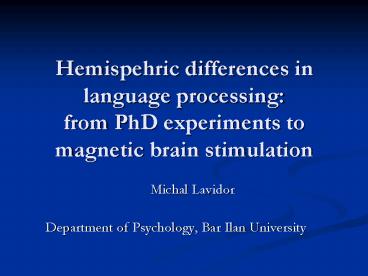Hemispehric differences in language processing: from PhD experiments to magnetic brain stimulation - PowerPoint PPT Presentation
1 / 41
Title:
Hemispehric differences in language processing: from PhD experiments to magnetic brain stimulation
Description:
Department of Psychology, Bar Ilan University ... loon, zion. deer. beer, dear, deed, deem, deep, doer, jeer, leer, peer, seer, veer ... – PowerPoint PPT presentation
Number of Views:78
Avg rating:3.0/5.0
Title: Hemispehric differences in language processing: from PhD experiments to magnetic brain stimulation
1
Hemispehric differences in language processing
from PhD experiments to magnetic brain
stimulation
- Michal Lavidor
- Department of Psychology, Bar Ilan University
2
Cerebral lateralisation of the left and right
visual fields.
3
Babkoff, Faust Lavidor, 1997 (cited 11 times)-
lexicality
Words
NonWords
4
What is TMS? A means of disrupting normal brain
activity by introducing neural noise.
5
(No Transcript)
6
(No Transcript)
7
Can TMS affect lexical decision?
- 4-letter words and non-words
- RVF, LVF and centre 150ms
- No-TMS, TMS over left V1, TMS over right V1
8
TMS pulse 65 Magstim Rapid 8Hz 70mm Fig 8 coil
1800ms
150 ms
500 ms
Response
lion
Search array
Fixation
9
rTMS effect size as a function of target position
and magnetic stimulation site.
10
rTMS effect size as a function of target position
and magnetic stimulation site.
11
rTMS effect size as a function of target position
and magnetic stimulation site (Lavidor et al.,
2003).
12
Word length (no. of letters)
- One of the hallmarks of expert reading is the
ability to identify arrays of several letters
quickly and in parallel. - This skill is acquired through years of academic
training, such that only after approximately 10
years of age do children show this typically
adult reading pattern.
13
Word length effects
- length-independent reading has only been found
for word stimuli appearing in the right visual
hemifield (RVF) (Bub Lewine, 1988 Ellis et
al., 1988 Young ellis, 1985).
14
Word length and hemispheresEllis, Young
Anderson, 1988
15
Word length and hemispheresEllis, Young
Anderson, 1988
16
Lavidor et al., 2002
17
VF and length interaction
- Structural factors (e.g., Cohen et al., 2002)
- Attentional factors (e.g., Kinsbourne, 1970)
- Reading habits and linguistic factors (e.g.,
Nazir, 2000)
18
Aims
- To investigate the comparative efficiency with
which the two hemispheres are able to recognise
visually presented words - To investigate whether the RVF specialisation is
due to structural or other factors.
19
Method
- 5- and 8-letter words and non-words were
presented at fixation with a LVF- or RVF-bias.
EXCEL LVF EXORCISE
YEARN RVF LOVELORN
0.8º
20
Method (cont.)
- There were 4 conditions of TMS
- No TMS
- TMS over the left occipital
- TMS over the right occipital
- Sham TMS over the left or right occipital (where
the coil was upturned from the scalp).
21
Predictions
- No-TMS condition length effect in the left but
not right visual field. - What will happen to the processing of RVF words
when LH is stimulated? - Can we create a word length effect in the RVF/LH?
22
Method (cont.)
23
Time (ms)
3000 ms
excel
Stimulus Onset (120 ms)
Fixation (500 ms)
24
Results
n 11
No TMS
720
700
680
5-lw
RT (ms)
660
8-lw
640
620
600
LH/RVF
RH/LVF
Visual Field
Mean lexical decision RTs to words as a function
of TMS, length and visual field.
25
Results
n 11
No TMS
Left TMS
720
700
680
5-lw
RT (ms)
660
8-lw
640
620
600
LH/RVF
RH/LVF
LH/RVF
RH/LVF
Visual Field
Mean lexical decision RTs to words as a function
of TMS, length and visual field.
26
Results
n 11
Right TMS
No TMS
Left TMS
720
700
680
5-lw
RT (ms)
660
8-lw
640
620
600
LH/RVF
RH/LVF
LH/RVF
LH/RVF
RH/LVF
RH/LVF
Visual Field
Mean lexical decision RTs to words as a function
of TMS, length and visual field.
27
Results
n 11
Right TMS
No TMS
Left TMS
Sham TMS
720
700
680
5-lw
RT (ms)
660
8-lw
640
620
600
LH/RVF
RH/LVF
LH/RVF
LH/RVF
LH/RVF
RH/LVF
RH/LVF
RH/LVF
Visual Field
Mean lexical decision RTs to words as a function
of TMS, length and visual field.
28
Findings
- Without TMS, length effects were apparent in the
LVF, but not in the RVF. - Left occipital TMS created a length effect in the
RVF, whilst right occipital TMS seemed only to
uniformly lengthen RTs to LVF stimuli. - As expected, performance in the Sham TMS
condition was almost identical to that in the No
TMS condition.
29
Orthographic Neighbourhood (N)
- lion
- loon, zion
- deer
- beer, dear, deed, deem, deep, doer, jeer, leer,
peer, seer, veer - large-N speeds up lexical decision in English
30
Hemispheric asymmetries in neighbourhood
effectsLavidor Ellis (2002a, b)
31
Lead (LN) and end-neighbours (EN)
cheese
0
32
Mean Reaction Times defined by lead-N (Lavidor et
al., 2004).
castle cheese cement coffin
33
rTMS effect size as a function of word
orthographic neighbourhood size and magnetic
stimulation site (Lavidor Walsh, 2003).
castle cheese cement coffin
34
rTMS effect size as a function of word
orthographic neighbourhood size and magnetic
stimulation site (Lavidor Walsh, 2003).
castle cheese cement coffin
35
(No Transcript)
36
Conclusions
- The ability to respond to initial letters of
centrally presented words is dependent upon RH
processes. - ?The results support the split fovea theory,
where the RH has primacy in representing lead
neighbours of a written word.
37
MiXeD CaSe affects RVF (Lavidor et al., 2003)
38
Mixed Case (Ellis et al., 2005)
aMbItion fixation collApSe
39
(No Transcript)
40
Accuracy results
41
Conclusions of the TMS and MC study































